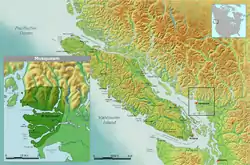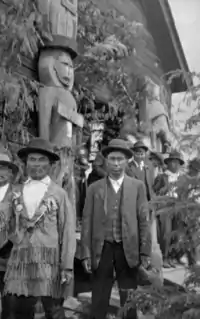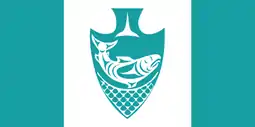Musqueam Indian Band
The Musqueam Indian Band (Halkomelem: xʷməθkʷəy̓əm IPA: [xʷməθkʷəjˀəm]) is a First Nations band government in the Canadian province of British Columbia and is the only First Nations band whose reserve community lies within the boundaries of the City of Vancouver.
Musqueam Indian Band
xʷməθkʷəy̓əm Musqueam | |
|---|---|
 Territory of the Musqueam Indian Band | |
| Country | Canada |
| Province | British Columbia |
| Government | |
| • Type | Band council |
| • Chief | Wayne Sparrow |
| • Councillors | List of Councillors
|
| Area | |
| • Total | 1,448.88 km2 (559.42 sq mi) |
| Time zone | UTC-8 (PST) |
| • Summer (DST) | UTC-7 (PDT) |
| Postal code span | V3H, V3J–N, V3V V4C, V4K, V4G V5- to V7- |
| Area code(s) | 604, 778 |
| Ethnic groups | Coast Salish |
| Languages | Halkomelem, English |
| Website | www |

Name
The name Musqueam relates back to the flowering plant, məθkʷəy̓, which grows in the Fraser River estuary. There is a sχʷəy̓em̓ that has been passed on from generation to generation that explains how they became known as the xʷməθkʷəy̓əm – People of the məθkʷəy̓ plant. Their name is one of the ways that their historical connection to the land is highlighted. The old people spoke of a small lake called xʷməm̓qʷe:m (Camosun Bog) where the sʔi:ɬqəy̓ (double-headed serpent) originated. They were warned as youth to be cautious and not go near or they would surely die. This sʔi:ɬqəy̓ was so massive its winding path from the lake to the stal̕əw̓ (river) became the creek flowing through Musqueam to this day. Everything the serpent passed over died and from its droppings bloomed a new plant, the məθkʷəy̓. For this reason, the people of long ago named that place xʷməθkʷəy̓əm (Musqueam – place of the məθkʷəy̓).[2]
History
The Musqueam people are the oldest-known residents of Vancouver. The Great Marpole Midden[3] (also known as the Eburne Site, or Great Fraser Midden), is an ancient Musqueam village and burial site located in the Marpole neighbourhood of Vancouver, British Columbia. Also known as the Great Fraser Midden, a thousands-year old deposit of skeletal remains, artifacts, stone and wooden tools, artwork and shells.[4] The village itself was known as c̓əsnaʔəm.[4] Formerly there was a second residential area near the current one, maləy̓, known in English as Mahlie.[5]
The Musqueam's ancestors, the Coast Salish, have lived in the Fraser River estuary for thousands of years. Their traditional territory encompasses the lands, lakes, and streams defined and included by a line commencing at Harvey Creek in Howe Sound and proceeding eastward to the height of land and continuing on the height of land around the entire watershed draining into English Bay, Burrard Inlet, and Indian Arm; south along the height of land between Coquitlam River and Brunette River to the Fraser River, across to the south or left bank of the Fraser River and proceeding downstream taking in the left bank of the main stream and the South Arm to the sea, including all those intervening lands, islands and waters back along the sea shore to Harvey Creek, and the sea, its reefs, flats, tidal lands, and islands adjacent to the above described land and out to the centre of Georgia Strait.
The area of the Musqueam Reserve is the closest Hudson's Bay Company explorer Simon Fraser made it to the Strait of Georgia; he was driven back by hostile Musqueam who had had bad experiences with white men on ships just prior. Chief Whattlekainum of the Kwantlen warned Fraser of an impending attack, thereby saving his life.
Language
Their traditional language is hən̓q̓əmin̓əm̓, the Downriver Dialect of the Salishan language Halkomelem, and they are closely related to neighbouring peoples of the lower Fraser River. The nearby Kwantlen and Katzie peoples just upriver share the same hən̓q̓əmin̓əm̓ dialect, while the upriver Sto:lo people speak another dialect, Halq’əméyləm (known as the Upriver Dialect). The Cowichan, Chemainus, Snuneymuxw and neighbouring Coast Salish peoples of Vancouver Island and the parts of the Gulf Islands of the southern Gulf of Georgia speak another dialect, Hul'qumi'num' (usually spelled Hulquminum), often called the Straits dialect, or Island Halkomelem, but not to be confused with North Straits Salish, which is a group of related dialects to the south.
In early 2018 the University of British Columbia installed at its main campus 54 street signs in the Musqueam language, written in Americanist phonetic notation. (In 2010, UBC’s Okanagan satellite campus had put up signs in Nsyilxcen, the language of the Okanagan Nation. Before the 2010 Olympic Games, the British Columbia government installed road signs in Squamish, Lil’wat and English on the Sea-to-Sky Highway between Whistler and Vancouver, BC.)[6]
The xʷməθkʷəy̓əm Musqueam dialect, hən̓q̓əmin̓əm is from the Hul’q’umi’num’/Halq'eméyle/hən̓q̓əmin̓əm language family.[7]
Indian Reserves
Indian Reserves under the administration of the band are:[8]
- Musqueam Indian Reserve No. 2, at the mouth of the Fraser River to the north of Sea Island, 190.40 ha.[9]49°14′00″N 123°13′00″W
- Musqueam Indian Reserve No. 4, to the east of Canoe Passage near Westham Island, 57.30 ha.[10]49°04′00″N 123°07′30″W
- Sea Island Indian Reserve 3, on the northwest corner of Sea Island, 6.50 ha.[11]49°12′00″N 123°12′00″W
The former Musqueam Indian Reserve No. 1, known in hən̓q̓əmin̓əm̓ as qiqéyt, in Halqemeylem as Qiqayt, and often anglicized historically as Kikait, is now named the New Westminster Indian Reserve and in recent times was allocated to the fledgling Qayqayt First Nation after many years of not being attached to any band.
Notes
- Chief & Council - Musqueam
- https://www.musqueam.bc.ca/our-story/who-we-are/
- Parks Canada 2010.
- Musqueam Indian Band 2011.
- Early Vancouver, Vol. 1, Maj. J. S. Mathews, Vancouver Archives
- Seal, Andrew (April 4, 2018). "UBC adds Musqueam language to street signs on campus". The Globe and Mail. Retrieved February 25, 2019.
- FPHLCC 2011–2012.
- Indian and Northern Affairs Canada – Reserves/Villages/Settlements detail Archived 2013-12-02 at the Wayback Machine
- "Musqueam 2". BC Geographical Names.
- "Musqueam 4". BC Geographical Names.
- "Sea Island 3". BC Geographical Names.
References
- "c̓əsnaʔəm", Musqueam: a living culture, Vancouver, BC: Musqueam Indian Band, 2011, archived from the original on 7 December 2013, retrieved 2 December 2013
- "Marpole Midden National Historic Site of Canada at Parks Canada". Parks Canada.
- "xʷməθkʷəy̓əm (Musqueam)", First Peoples Language Map, Aboriginal Languages Initiative (ALI), First Peoples' Heritage Language and Culture Council (FPHLCC), 2011–2012, retrieved 4 December 2013
- "Canada's Historic Places: Marpole Midden National Historic Site of Canada", Canadian Register, Parks Canada, 2010
- Roy, Susan (Winter 2006–2007). ""Who Were These Mysterious People?" – ç¢sna:m, the Marpole Midden, and the Dispossession of Aboriginal Lands in British Columbia". BC Studies (152): 67–95. Archived from the original on 2013-12-11. Retrieved 2013-12-06.
- These Mysterious People Shaping History and Archaeology in a Northwest Coast Community, McGill/Queen's University Press, October 2010, p. 240, ISBN 9780773537217
Further reading
- Dunkley, Katharine. Indian Rights and Federal Responsibilities: Supreme Court Musqueam Decision. [Ottawa]: Library of Parliament, Research Branch, 1985.
- Guerin, Arnold, and J. V. Powell. Hunq̓umỉn̉um ̉= Musqueam Language. Book 1. [Vancouver, B.C.?]: Musqueam Band, 1975.
- Johnson, Elizabeth Lominska, and Kathryn N. Bernick. Hands of Our Ancestors: The Revival of Salish Weaving at Musqueam. [Vancouver?]: University of British Columbia, Museum of Anthropology, 1986. ISBN 0-88865-108-2
- Suttles, Wayne P. Musqueam Reference Grammar. First Nations languages. Vancouver: UBC Press, 2004. ISBN 0-7748-1002-5
- Weightman, Barbara Ann. The Musqueam Reserve: A Case Study of the Indian Social Milieu in an Urban Environment. Seattle, Wash: University of Washington, 1978.
